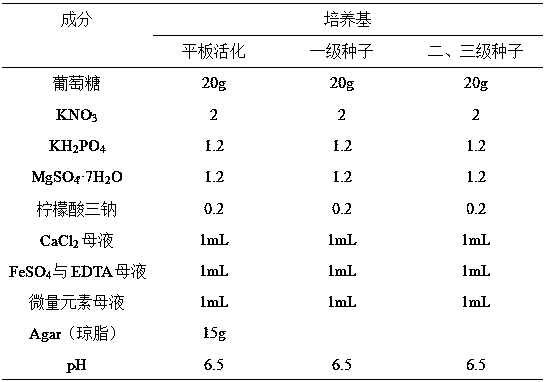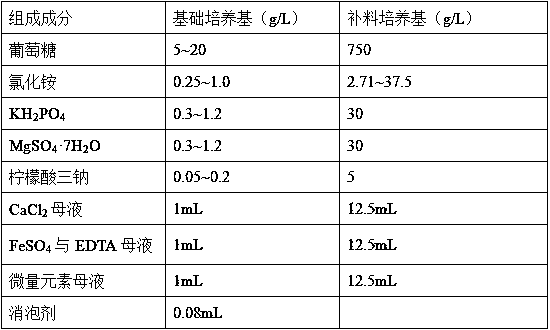Chlorella zofingiensis heterotrophic high-density culture method
A technology for high-density culture and chlorella, applied in the direction of microorganism-based methods, biochemical equipment and methods, single-cell algae, etc., can solve the problems of low biomass concentration and slow cell proliferation
Inactive Publication Date: 2019-05-24
INST OF AQUATIC LIFE ACAD SINICA
View PDF3 Cites 5 Cited by
- Summary
- Abstract
- Description
- Claims
- Application Information
AI Technical Summary
Problems solved by technology
[0007] In order to solve the existing chlorella Chlorella zofingiensis The problem of slow cell proliferation and low biomass concentration when using nitrate nitrogen and fixed carbon-nitrogen ratio in the high-density culture process, the invention provides a kind of chlorella Chlorella Zofingiensis The heterotrophic high-density culture method uses ammonium salts with low energy consumption in the process of absorption and utilization as the nitrogen source, and at the same time abandons the traditional fixed carbon-nitrogen ratio feeding, instead, it is based on the pH drop caused by Chlorella in the process of using nitrogen sources. Adaptively supplement ammonia water, during the process of supplementing ammonia water, on the one hand, maintain an appropriate and constant pH in the heterotrophic environment of microalgae by supplementing ammonia water, on the other hand, ammonia water is also used as a nitrogen source supplement for algae cell growth Therefore, the nitrogen source provided by ammonia water is actually supplemented adaptively according to the nitrogen utilization and demand of microalgae cells, thereby avoiding the limitation of microalgae growth caused by feeding with a fixed carbon-nitrogen ratio, and improving the growth rate of cells. Growth Rate and Biomass Concentration Purposes for Chlorella Chlorella zofingiensis Provide technical support for heterotrophic high-density culture of its mutants
Method used
the structure of the environmentally friendly knitted fabric provided by the present invention; figure 2 Flow chart of the yarn wrapping machine for environmentally friendly knitted fabrics and storage devices; image 3 Is the parameter map of the yarn covering machine
View moreImage
Smart Image Click on the blue labels to locate them in the text.
Smart ImageViewing Examples
Examples
Experimental program
Comparison scheme
Effect test
Embodiment Construction
[0046] In order to further understand the present invention, the present invention is described below in conjunction with examples, but the examples are only to further illustrate the features and advantages of the present invention, rather than limiting the claims of the present invention.
the structure of the environmentally friendly knitted fabric provided by the present invention; figure 2 Flow chart of the yarn wrapping machine for environmentally friendly knitted fabrics and storage devices; image 3 Is the parameter map of the yarn covering machine
Login to View More PUM
 Login to View More
Login to View More Abstract
The invention discloses a Chlorella zofingiensis heterotrophic high-density culture method which is characterized in that Chlorella zofingiensis is inoculated into a fermentation tank and cultured, aused basal culture medium and a used fed-batch culture medium take ammonium salt as a nitrogen source, the carbon nitrogen ratio of the basal culture medium is 5:(1-80):1, the carbon nitrogen ratio ofthe fed-batch culture medium is 5-20 times that of the basal culture medium, the pH (potential of hydrogen) value of a culture system is monitored in real time during culture, adjusted by adding ammonia water according to monitoring results and kept 6.5+ / -0.2 to supplement the nitrogen source, the glucose concentration of the culture system is monitored in real time during culture, feeding of thefed-batch culture medium is started when the glucose concentration of the basal culture medium is reduced to 3-4 g / L, and the variation amplitude of the glucose concentration of the culture system islower than 20% within any two hours by the aid of feeding speed. According to the characteristic of pH reduction in the ammonium salt using process of cells, the pH is regulated by the aid of the ammonia water to supplement the nitrogen source. The culture method can effectively avoid the inhibitory effect of nitrogen source excess or deficiency in an existing fixed carbon nitrogen ratio feedingculture mode on cell growth.
Description
technical field [0001] The invention relates to the technical field of microalgae cultivation, in particular to a method for heterotrophic high-density cultivation of chlorella. Background technique [0002] Astaxanthin is a purple-red ketone carotenoid with strong coloring and anti-oxidation functions, and is widely used in aquaculture, food, medicine, cosmetics and other fields. Chlorella Chlorella zofingiensis It is a single-cell green algae, which grows fast and can efficiently accumulate astaxanthin. It is considered to be another source of natural astaxanthin production that has attracted much attention after Haematococcus pluvialis and Phaffia rhodozyme [Document 1: IP PF, Chen F. Peroxynitrite and nitrylchloride enhance astaxanthin production by the green microalga Chlorellazofingiensis in heterotrophic culture. Process Biochemistry, 2005, 40: 3595-3599]. Chlorella sp. as a novel potential microalgae for industrial astaxanthin production Chlorella zofingiensis Not...
Claims
the structure of the environmentally friendly knitted fabric provided by the present invention; figure 2 Flow chart of the yarn wrapping machine for environmentally friendly knitted fabrics and storage devices; image 3 Is the parameter map of the yarn covering machine
Login to View More Application Information
Patent Timeline
 Login to View More
Login to View More Patent Type & Authority Applications(China)
IPC IPC(8): C12N1/12C12R1/89
Inventor 金虎侯国力陈剑平陈义蔡李鹏韩丹翔胡强
Owner INST OF AQUATIC LIFE ACAD SINICA
Features
- R&D
- Intellectual Property
- Life Sciences
- Materials
- Tech Scout
Why Patsnap Eureka
- Unparalleled Data Quality
- Higher Quality Content
- 60% Fewer Hallucinations
Social media
Patsnap Eureka Blog
Learn More Browse by: Latest US Patents, China's latest patents, Technical Efficacy Thesaurus, Application Domain, Technology Topic, Popular Technical Reports.
© 2025 PatSnap. All rights reserved.Legal|Privacy policy|Modern Slavery Act Transparency Statement|Sitemap|About US| Contact US: help@patsnap.com



